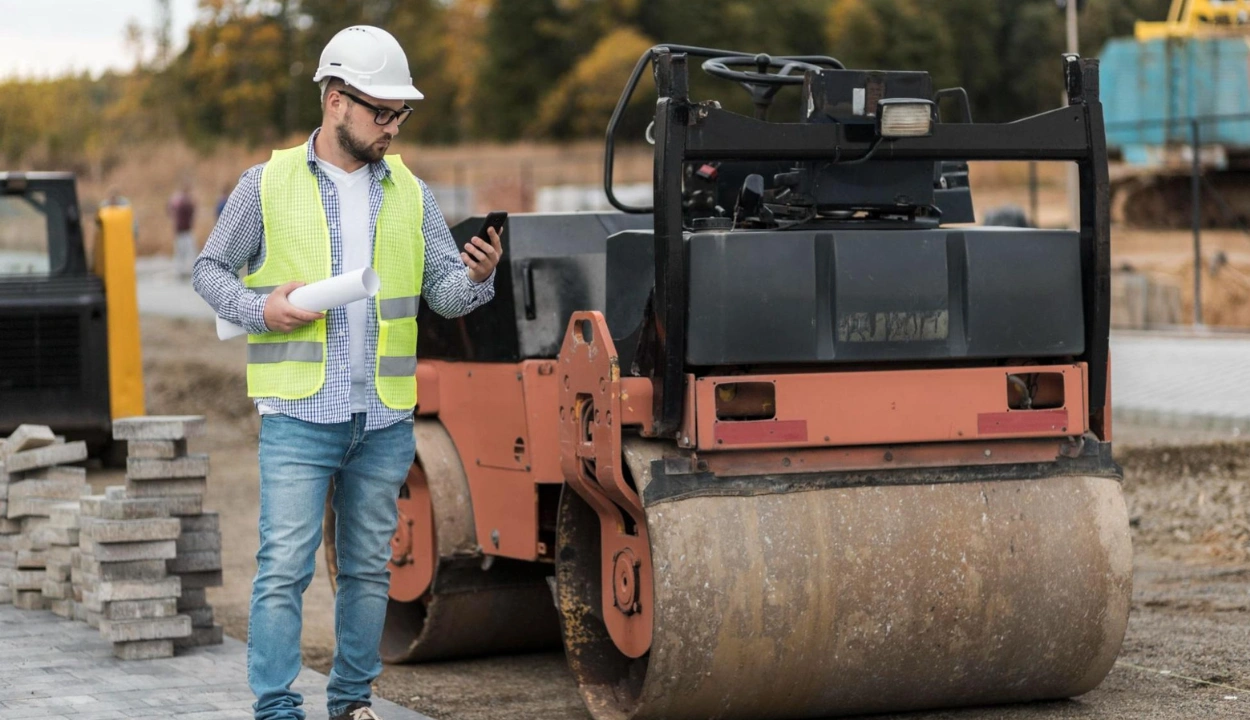Benefits of Equipment Utilization Report in Construction Projects
To figure out profits effectively, it's crucial to pay close attention to every bit of money.
Aiming for a high Return on Assets (ROA) shows how well the company turns resources into profits.
On the flip side, a low ROA could indicate problems in how assets are managed or in how well operations are run.
Yet, it's imperative to monitor the efficiency and productivity of machinery and tools over time.
Your business can be a part of this market if you start realizing the value of utility equipment services.
An equipment utilization report offers invaluable insights into usage patterns for optimized resource allocation and enhanced performance by closely tracking tool productivity.
Why Measure Equipment Utilization?

The construction equipment market is projected to reach USD 194.7 Billion by 2030.
Within the construction sector, equipment stands as the backbone of the industry.
Construction companies heavily invest in equipment, recognizing that superior equipment correlates with heightened profits.
Equipment utilization provides significant details about your operations, such as the latest trends in capacity and runtime.
You can use it effectively for future continuous improvement projects.
One can understand the significance of measuring machine utilization/equipment utilization from a simple fact: What you measure, you can improve.
Without any information regarding the performance of your equipment, decisions may lead to loss.
This is why it is crucial to establish your equipment utilization formula, create detailed plans to maximize utility equipment services, and assign tasks to your team.
Improving utilization leads to higher production, profits, and satisfied, loyal customers.
A world-class facility in the manufacturing industry is achievable with approximately 80% utilization.
The Formula to Calculate Machine Utilization
While it might appear complicated at first glance, it's pretty straightforward.
It boils down to Productive Machine Hours (PMH) and Scheduled Machine Hours (SMH).
PMH/SMH x 100
PMH represents the actual time a machine works within a specific period.
It is calculated by dividing the total operating hours by the total available hours in that period, then multiplying by 100.
For example, a machine that is supposed to run 16 hours a day (over 2 shifts) every 6 days per week is available for 96 hours a week (SMH).
If your machine runs for 68 hours a week (PMH), its utilization rate is 71%.
(68 hours96 hours)×100=71(96 hours68 hours)×100=71
This calculation demonstrates a utilization rate of 71%.
Software companies use the equipment utilization formula as follows:
Benefits of Equipment Utilization Report in Construction Projects
Although there are 100 reasons why a company should prioritize equipment utilization reporting, below, we've explained some of the key ones.
Maximize Sales and Optimizing Supply Chains

Your production data alone won't drive sales, but it can guide you in making informed decisions about sales strategies and product offerings.
Analyze the data to identify underutilized machines and adjust your production to focus on products that those machines can efficiently produce.
Additionally, equipment utilization reports can help allocate work to specific machines.
If your company operates across multiple sites or collaborates with smaller firms, use the data to determine which machines can handle additional workloads.
By optimizing machine usage within your facilities, you can reduce production costs and transportation expenses.
Consider utilizing monthly report templates and examples to streamline your business operations.
Improving Time to First Part/Time to Last Part
Operating your machines within the specified shift time is crucial.
Avoid unnecessary late starts and premature stops of your equipment to maximize uptime and profits.
Measure and understand how much time you lose per week, month, or year.
Calculating late starts and early stops is simple, and it enables you to make improvements based on the data you collect and review.
Additionally, you can calculate utilization costs by reviewing monthly data and using it to determine the number of hours lost annually and the associated costs based on your hourly production cost.
These calculations can help you identify the main reasons behind your issues, which can range from operators not arriving on time to lengthy machine warm-up times or cleaning requirements.
Once identified, finding appropriate solutions as a team becomes more accessible.
Review your data regularly and schedule daily or weekly meetings with your team for updates.
Making Better Capex Decisions
Are you concerned about not having enough capacity to fulfill a large contract or unsure if you need more machines to generate profits?
Utilization data will be invaluable.
You don't always need to justify not acquiring a machine.
Take the example of Belden Universal, which postponed buying two machines with the help of gathered data.
Suppose you've signed a new deal to complete a large order.
First, determine how many parts you expect to produce (e.g., 100,000 pieces/year) and multiply it by the predicted cycle time for each week, month, or year (3,333 hours at 2 min/piece).
Then, review utilization data and assess the number of machines available for operation.
If machines have not been available for a significant amount of time, consider purchasing new equipment.
Improving OEE
OEE stands for Overall Equipment Effectiveness, a metric that helps determine a machine's potential in your production line or factory.
Manufacturers can track OEE to discover where losses occur and take action to address those issues.
The primary OEE loss typically stems from availability (Availability = Runtime/Planned Production Time, which equals utilization).
Increasing equipment uptime will significantly impact your OEE, improving its three major components: performance, availability, and quality.
Enhanced Accountability and Productivity
When employees know that tools and equipment are being tracked and reports are generated, they use them carefully and correctly.
Tool and equipment tracking foster a sense of responsibility within the team, leading to improved handling practices and increased productivity.
Identifying and addressing equipment-related issues becomes easier, enhancing project success.
Streamlined Equipment Maintenance

Regular maintenance of construction equipment is essential to ensure its performance and longevity.
Equipment utilization reports can help set up maintenance alerts based on usage and time, reminding managers when equipment requires servicing or repairs.
Proactive maintenance prevents costly breakdowns, enhancing overall equipment reliability and increasing productivity on various construction sites.
Improved Asset Visibility
Equipment utilization reports provide insights into real-time visibility of your assets' whereabouts and status.
This enhanced visibility enables businesses to keep track of valuable resources, prevent loss or theft, and ensure equipment availability when needed.
Monitoring equipment remotely helps minimize downtime, maximize operational efficiency, and allocate resources effectively.
Enhanced Compliance and Safety
Equipment tracking reports ensure regulatory compliance and site safety.
Firstly, they verify that equipment is used according to regulatory standards, reducing the risk of non-compliance penalties and legal issues.
Secondly, potential safety hazards can be identified and addressed quickly by tracking equipment usage, reducing the likelihood of accidents or injuries on construction sites.
This proactive approach promotes a safer working environment and supports the project's overall compliance framework, leading to smoother operations and successful project outcomes.
Integrating Clue into Your Equipment Utilization Strategy
Integrating advanced analytics and reporting tools like Clue software into your operations is essential for maximizing insights from equipment utilization reports and driving efficiency and profitability.
Clue stands out as a leading Construction equipment utilization software, offering robust features specifically tailored to meet the unique demands of the construction industry.
Key Features of Clue
1. Real-Time Data Analysis
Clue excels in processing real-time data from construction equipment, providing immediate insights into equipment performance and usage patterns.
This capability ensures decision-makers are always equipped with the latest information to adjust operations for maximum efficiency.
2. Advanced Telematics Integration
Leveraging connections with major equipment manufacturers through APIs such as John Deere and Doosan, Clue facilitates seamless integration of telematics data.
This integration allows for comprehensive construction equipment tracking and analysis of equipment across various parameters, including usage, idle time, and maintenance schedules.
3. Customizable Alerts and Notifications
Set up personalized alerts for maintenance and operation anomalies.
These notifications help prevent costly downtimes and ensure that equipment is always in top working condition, directly enhancing asset lifespan and ROI.
4. User-Friendly Interface
With a focus on usability, Clue offers a streamlined interface that simplifies the complexity of data analytics.
This design ensures that all stakeholders, regardless of their tech savviness, can easily navigate and utilize the system to its full potential.
5. Robust Reporting Tools
Generate detailed reports that align with your company's specific needs.
Whether it's daily operation summaries or deep dives into long-term usage trends, Clue provides the tools to create actionable reports that drive decision-making.
6. Mobile Compatibility
Access key metrics and insights on the go with Clue's mobile app.
This feature is crucial for on-site management, providing real-time data to foremen and project managers directly on their smartphones or tablets.
Wrapping Up
The construction industry is continuously evolving.
Equipment utilization reports assist construction companies in optimizing equipment usage, maximizing project efficiency, and making informed decisions to ensure successful outcomes.
Obtain equipment utilization reports to distinguish yourself among construction companies and attract loyal customers.
FAQs
Why is Equipment Utilization Important?
Equipment utilization measures how effectively site machinery is used and performed.
It helps businesses improve job site productivity, reduce equipment rental costs, and minimize project delays.
What is the Utilization Factor in Construction?
The utilization factor in construction refers to the ratio of the utilized solar heat gain to the total solar heat gain in a building.
It is influenced by weather and the building's thermal response.
How Do You Measure Equipment Utilization?
Equipment utilization is measured by dividing the actual operation time by the scheduled available hours.
This metric helps you understand how efficiently your equipment is running, identify areas for improvement, and make more informed business decisions.
Transform Your Equipment Management













